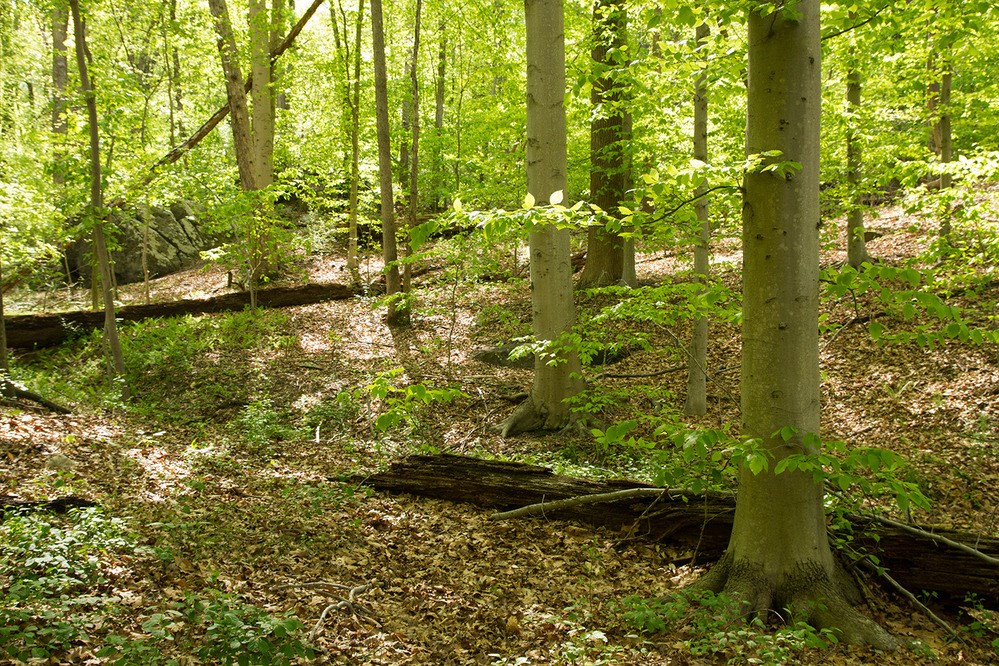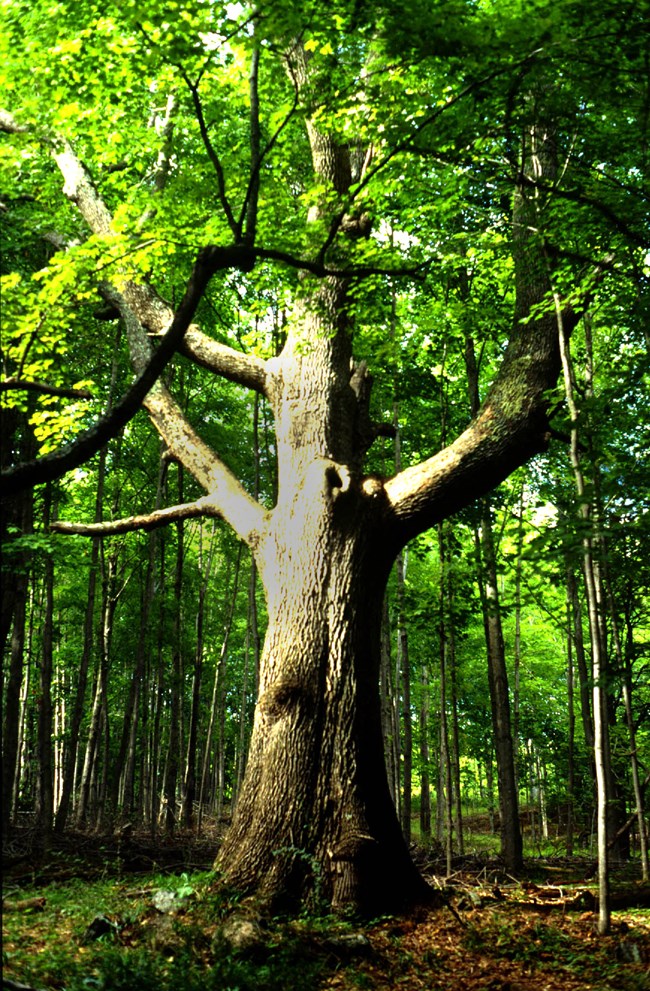Part of a series of articles titled Managing Resilient Forests Initiative for Eastern National Parks.
Article
Managing Resilient Forests. A Regional Initiative

NPS image
Forests in NPS Region 1 are Complex and Important, but Need Help for Long-term Success.
Forests cover tens of thousands of acres in eastern national parks. A recent analysis of over a decade’s worth of five regional Inventory & Monitoring (I&M) Networks data showed that they consistently contained more complex structure and dynamics typical of older forests. Eastern national parks had more large live trees over 2-feet in diameter (about 80% higher than surrounding forests) and wildlife-friendly standing dead large trees. There was also more decomposing tree matter on the forest floor that is vital for many plants and animals, averaging 135% of the volume found in surrounding forests. For more on this study, see the NPS article: National Park Forest – More Than a Pretty Picture.
For the long-term, the same monitoring data identified concerning, region-wide trends in tree regeneration that indicate significant threats to the sustainability of these critical ecoysytems. Park forests are facing a range of interacting stressors including over-abundant white-tailed deer populations, invasive plant invasion, novel pests and pathogens, development of surrounding lands, altered disturbance regimes, increasingly frequent extreme weather events, and changing climate conditions. At worst, these stressors can lead to the replacement of a parks’ native forest with thickets of exotic invasive shrubs that smother wildflowers and other native plants, impede cultural viewsheds, and can increase visitor exposure to disease-carrying ticks. Collectively, these impacts will result in increased costs for visitor safety management and to preserve park infrastructure, and lead to changes in the overall character of a park visitors have enjoyed for generations.

NPS image.
More Tall Trees, Please.
An abundant regeneration layer containing tree seedlings and saplings (small trees) of varying sizes and of made up of species matching those in the fully grown canopy is an important component of a healthy forest. Many parks lack the minimum levels of seedlings and saplings needed to replace canopy trees as they die, whether from age, fire, extreme weather, or the effects of non-native pests and pathogens. In most parks, non-native plant abundance is increasing as well which further suppresses tree regeneration. Forests that lack sufficient regeneration, or the young species don’t match the current canopy species, suffer from what is called “regeneration debt” (Miller & McGill 2019). The most severe form of regeneration debt is a complete lack of regeneration, which, if allowed to persist, can ultimately lead to loss in forest habitat.The I&M networks of the northeast have launched the Managing Resilient Forests Initiative to raise awareness of threats to forest health and foster collaboration across the region.
Park Forests Have Urgent Management Needs
Based on these troubling trends, I&M scientists are concerned that parks in the Eastern U.S. need active management approaches to restore or sustain their forests over the long term. Managing for resilient park forests is imperative to ensure long-term ecosystem health, maintain biodiversity, and meet the NPS mission of preserving park resources unimpaired for future generations.
For More information
Contact:
Stephanie Perles
Vegetation Ecologist, Eastern Rivers and Mountains Network
(814)-441-9643
Dowlnoad the Resource Brief
Tags
- acadia national park
- allegheny portage railroad national historic site
- antietam national battlefield
- appomattox court house national historical park
- bluestone national scenic river
- booker t washington national monument
- catoctin mountain park
- chesapeake & ohio canal national historical park
- colonial national historical park
- delaware water gap national recreation area
- eleanor roosevelt national historic site
- fort necessity national battlefield
- fredericksburg & spotsylvania national military park
- friendship hill national historic site
- gauley river national recreation area
- george washington memorial parkway
- george washington birthplace national monument
- gettysburg national military park
- harpers ferry national historical park
- home of franklin d roosevelt national historic site
- hopewell furnace national historic site
- johnstown flood national memorial
- manassas national battlefield park
- marsh - billings - rockefeller national historical park
- minute man national historical park
- monocacy national battlefield
- morristown national historical park
- national capital parks-east
- new river gorge national park & preserve
- petersburg national battlefield
- prince william forest park
- richmond national battlefield park
- rock creek park
- sagamore hill national historic site
- saint-gaudens national historical park
- saratoga national historical park
- thomas stone national historic site
- valley forge national historical park
- vanderbilt mansion national historic site
- weir farm national historical park
- wolf trap national park for the performing arts
- invasive plant management
- resilient forest management
- white tailed deer
- deer management plan
- deer management
- ermn
- vegetation
- midn
- resilient forests initiative
- netn
- northeast temperate network
- mid-atlantic network
- eastern rivers and mountains network
- ncbn
- northeast coastal and barrier network
- ncrn
- national capital region network
Last updated: August 20, 2024
